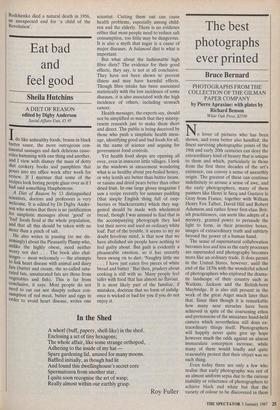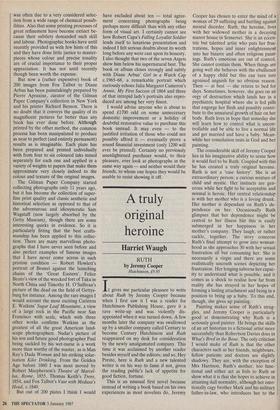The best photographs ever printed
Bruce Bernard
PHOTOGRAPHS FROM THE COLLECTION OF THE GILMAN PAPER COMPANY by Pierre Apraxine: with plates by Richard Benson
White Oak Press, $2500
No lover of pictures who has been shown, and even better also handled, the finest surviving photographic prints of the 19th and early 20th centuries can deny the extraordinary kind of beauty that is unique to them and which, particularly in those from the first three decades of the art's existence, can convey a sense of unearthly origin. The greatest of these can continue indefinitely to arouse a sense of awe, and the early photographers, many of them painters like Henri le Secq and Gustave le Gray from France, together with William Henry Fox Talbot, David Hill and Robert Adamson and rather fewer first-class Brit- ish practitioners, can seem like adepts of a mystery, granted power to persuade the light to form, in their primitive boxes, images of extraordinary truth and subtlety beyond the power of a human hand.
The sense of supernatural collaboration becomes less and less as the early processes are superseded and photography becomes more like an ordinary trade. It does persist in the United States, however, until the end of the 1870s with the wonderful school of photographers who explored the drama- tic landscape of their country such as Watkins, Jackson and the British-born Muybridge. It is also still present in the work of the great Atget much later than that. Since then though it is remarkable how many near miracles have been achieved in spite of the coarsening ethos and pretensions of the miniature hand-held camera which nevertheless still does ex- traordinary things itself. Photographers will happily never quite give up hope however much the odds against an almost immaculate conception increase, while many of them would loudly and quite reasonably protest that their object was no such thing. .
Even today there are only a few who realise that early photography was not of an almost uniform sepia due to the curious inability or reluctance of photographers to achieve black and white but that the variety of colour to be discovered in them was often due to a very considered selec- tion from a wide range of chemical possib- ilities. Also that some printing processes of great refinement have become extinct be- cause their subtlety demanded such skill and labour. Photographic books have until recently provided us with few hints of this and they have done little justice to master- pieces whose colour and precise tonality are of crucial importance to their proper appreciation. It has not until recently though been worth the expense.
But now a (rather expensive) book of 200 images from Fox Talbot to Diane Arbus has been painstakingly prepared by Pierre Apraxine, curator of the Gilman Paper Company's collection in New York and his printer Richard Benson. There is no doubt that it conveys the quality of its magnificent pictures far better than any book has ever done before. Although printed by the offset method, the common process has been manipulated to produce as near to perfect (and entirely permanent) results as is imaginable. Each plate has been prepared and printed individually with from four to six coloured inks mixed separately for each one and applied in a variety of weights to papers that make them approximate very closely indeed to the colour and texture of the original images.
The Gilman Paper Company started collecting photographs only 11 years ago, but it has become the collection of super- fine print quality and classic aesthetic and historical selection as opposed to that of the adventurous and idiosyncratic Sam Wagstaff (now largely absorbed by the Getty Museum), though there are some interesting quirks in evidence. So it is particularly fitting that the best crafts- manship has been applied to this collec- tion. There are many marvellous photo- graphs that I have never seen before and also perfect examples of famous images that I have never come across in such pristine condition — Robert Howlett's portrait of Brunel against the launching chains of the 'Great Eastern', Felice Beato's view of the wrecked fort of Taku in North China and Timothy H. O'Sullivan's picture of the dead on the field of Gettys- burg for instance. Among the rare images I would account the most exciting Carleton E. Watkins' Sugar Loaf Mountains, a view of a large rock in the Pacific near San Francisco with seals, which with three other works confirms Watkins as the greatest of all the great American land- scape photographers. Nadar's picture of his son and future good photographer Paul being suckled by his wet-nurse is a work more than worthy of the master, as is Man Ray's Dada Woman and his striking solar- isation Kike Drinking. From the Golden Age before 1860 I was most moved by Robert Macpherson's Theatre of Marcel- lus, Rome, 1855, Thomas Keith's Trees, 1854, and Fox Talbot's Vase with Medusa's Head, c.1840.
But out of 200 plates I think I would have excluded about ten — total agree- ment concerning photographs being perhaps more difficult than with any other form of visual art. I certainly cannot see how Robert Capa's Falling Loyalist Soldier lends itself to luxurious presentation and indeed I felt serious doubts about its worth long before any were cast upon its honesty. I also thought that two of the seven Atgets show him below his supernatural best. The book or album closes strongly and subtly with Diane Arbus' Girl in a Watch Cap c.1965-68, a remarkable portrait which curiously echoes Julia Margaret Cameron's Annie, My First Success of 1864 and three of that intrepid lady's portraits also repro- duced are among her very finest.
I would advise anyone who is about to spend £1700 odd on some unneccesary domestic improvement or a holiday of doubtful restorative value to purchase this book instead. It may even — to the justified irritation of those who could not possibly afford it — eventually prove a sound financial investment (only 1200 will ever be printed). Certainly no previously unenlightened purchaser would, to their pleasure, ever look at photographs in the same way again — and neither would their friends, to whom one hopes they would be unable to resist showing it off.











































 Previous page
Previous page